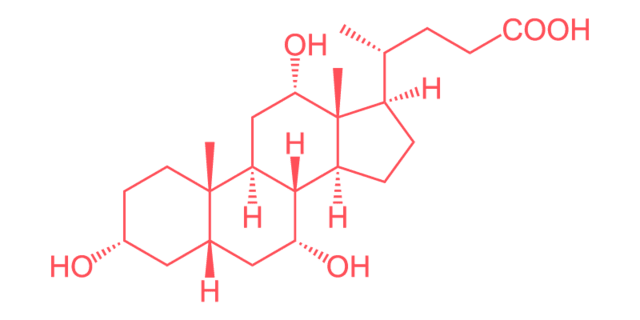Cholic Acid

Linear Formula
C24H40O5
Synonyms
3α,7α,12α-trihydroxy-5β-cholan-24-oic acid
Share this metabolite
What is Cholic Acid?
Cholic acid, or cholate, is a primary bile acid produced in the liver from cholesterol and represents a major component of the total bile acid pool in humans. Bile acids play a critical role in the digestion and absorption of dietary fats. After a meal, bile acids are released into the small intestine to help emulsify fats, allowing them to be broken down by enzymes and absorbed into the bloodstream.1 Consequently, cholic acid is often used to treat patients with bile acid synthesis disorders. Cholic acid is involved in numerous physiological processes in the body, and its disruption can lead to various health issues, including liver and gastrointestinal diseases.
Cholic Acid Signaling
Primary bile acid synthesis takes place in the liver. Primary bile acids are then converted to bile salts by conjugation with amino acids glycine or taurine. Before cholic acid is secreted into the intestine, liver cells conjugate it with these amino acids to form conjugated bile acids (glycocholic acid and taurocholic acid).1
Once primary bile acids are secreted into the intestinal lumen, intestinal microbiota can dehydroxylate them to form secondary bile acids. Primary bile acid dehydroxylation is a process in which primary bile acids lose one or more hydroxyl (-OH) groups from their molecular structure. Gut microbiota promotes the formation of secondary bile acids, including deoxycholic acid and ursocholic acid.2
Cholic Acid’s Role in Cholesterol Metabolism
Cholic acid plays a crucial role in the excretion of waste products from the body. The excretion of cholic acid in feces eliminates excess cholesterol from the body. Cholesterol cannot decompose into smaller molecules in our body, so it must be converted into bile acids in the liver to be broken down and excreted in the feces.3 Alterations in the metabolism or secretion of cholic acid can lead to the accumulation of cholesterol and other waste products, which can contribute to the development of several diseases, including obesity.
Cholic Acid’s Role in Liver Diseases
Bile acid disorders can contribute to the development and progression of hepatic disease. Cholestasis is a hepatic disease that results from disrupted cholic acid secretion, leading to a buildup of toxic bile acids in the liver.4 If left untreated, cholestasis can cause liver damage, inflammation, and fibrosis, ultimately leading to liver failure.
Zellweger spectrum disorders are a group of rare genetic disorders with multisystem manifestations primarily affecting the liver. A study showed that cholic acid therapy improved liver function and reduced the severity of hepatic disease in patients with Zellweger spectrum disorders.5 Cholic acid supplementation improves the breakdown of certain fats in the liver, reducing the accumulation of toxic substances and improving liver function.
Cholic Acid’s Role in Gastrointestinal Diseases
Cholic acid has also been implicated in the pathogenesis of several gastrointestinal (GI) disorders, including inflammatory bowel disease (IBD) and colon cancer. Studies have shown that high bile acid levels can promote inflammation and damage to the intestinal epithelium, which can contribute to the development of IBD.6
Similarly, elevated levels of cholic acid have been observed in patients with esophageal and colon cancer. Some studies have suggested that bile acids may promote tumor growth and metastasis by altering signaling pathways that modulate the tumor microenvironment.7
Cholic Acid’s Role in Neuroscience
Bile acid synthesis also plays a critical role in the development of neurodegenerative diseases. For example, high cholic acid levels (and other bile acids) in the brain are linked to cognitive decline. Metabolomics has shown that post-mortem brain samples from individuals with Alzheimer’s disease (AD) have higher levels of primary conjugated and secondary bile acids than controls.8 Alterations in bile acid metabolism have been elucidated as possible biomarkers for prognosis tools in multiple cognitive dysfunction-related diseases.
References
- LiverTox: Clinical and Research Information on Drug-Induced Liver Injury [Internet]. Bethesda (MD): National Institute of Diabetes and Digestive and Kidney Diseases; 2012-. Cholic Acid. [Updated 2016 Nov 7].Available from:https://www.ncbi.nlm.nih.gov/books/NBK548276/?report=classic
- Funabashi M, Grove TL, Wang M, et al. A metabolic pathway for bile acid dehydroxylation by the gut microbiome.Nature. Jun 2020;582(7813):566-570. doi:10.1038/s41586-020-2396-4
- Sato R. Recent advances in regulating cholesterol and bile acid metabolism.Biosci Biotechnol Biochem. Nov 2020;84(11):2185-2192. doi:10.1080/09168451.2020.1793658
- Kriegermeier A, Green R. Pediatric Cholestatic Liver Disease: Review of Bile Acid Metabolism and Discussion of Current and Emerging Therapies.Front Med (Lausanne). 2020;7:149. doi:10.3389/fmed.2020.00149
- Klouwer FCC, Koot BGP, Berendse K, et al. The cholic acid extension study in Zellweger spectrum disorders: Results and implications for therapy. J Inherit Metab Dis. Mar 2019;42(2):303-312. doi:10.1002/jimd.12042
- Tiratterra E, Franco P, Porru E, Katsanos KH, Christodoulou DK, Roda G. Role of bile acids in inflammatory bowel disease.Ann Gastroenterol. 2018;31(3):266-272. doi:10.20524/aog.2018.0239
- Phelan JP, Reen FJ, Caparros-Martin JA, O’Connor R, O’Gara F. Rethinking the bile acid/gut microbiome axis in cancer.Oncotarget. Dec 29 2017;8(70):115736-115747. doi:10.18632/oncotarget.22803
- Baloni P, Funk CC, Yan J, et al. Metabolic Network Analysis Reveals Altered Bile Acid Synthesis and Metabolism in Alzheimer’s Disease.Cell Rep Med. Nov 17 2020;1(8):100138. doi:10.1016/j.xcrm.2020.100138
